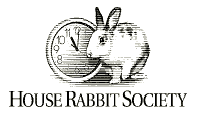Here we offer only a brief summary of some rabbit care issues and suggestions. Extensive and detailed care information is available at: House Rabbit Society.
Health Tips
- Choking – every rabbit person should review the video and detailed information on this page! If you ever witness your rabbit choking you won’t have the time to look up the details needed to save their life. The danger of choking is a particular hazard for bunnies who gobble their pellets. You can help prevent this from happening by scattering their pellets around for them to find, instead of placing them in a dish.
- It’s an Emergency if your rabbit stops eating! Take immediate steps to correct the problem. Often this is due to stomach gas (rabbits cannot burp or vomit) which is often cured with simethecone. We use Ovol brand of simethecone, which is a gas relief medicine for human babies. Using a syringe, give 1cc to small rabbits and 2cc to medium or large rabbits. Try to gently massage the stomach area. Wait 1 hour and give another dose. Offer a favourite treat and if your rabbit still will not eat or appears in distress call a rabbit-savvy vet immediately. For important information on a rabbits digestive system see “The Mystery of Rabbit Poop”.
- Make sure your bunny is passing well-formed, solid droppings and a good quantity every day.
- Pay attention to your rabbits urine. If it is thick and white in colour this may be a sign of too much calcium in its diet.
- Have your rabbit neutered or spayed – essential for long term health and improved behaviour.
- Trim your rabbits nails every two months.
Rabbit Food
Remember, never change a rabbits diet suddenly. If you add new foods do it slowly watching carefully for changes in the digestive system.
- Hay – good quality grass hay such as timothy, or orchard grass – as much as the bunny wants.
- Pelleted feed – (no more than 14% protein) – alfalfa or timothy formulas – adults ( 8 months +) should get timothy pellets limited to 1/4 cup per day for medium sized rabbits. Always feed plain pellets. Avoid brands with seeds, nuts, corn, dried fruit etc.
- Fresh vegetables – about 2 cups per day. We feed primarily leaf lettuce, carrot tops, cilantro, and parsley but many other vegetables are okay. veggie list
- Fresh water – changed regularly. Water bowls please. They are easier to clean and a more natural way for the bunny to drink. A study showed that rabbits with water bottles had more health problems due to dehydration. Licking one drop at a time means they never get enough water.
- Treats (to be given sparingly) – Carrots, parsnips, apple, banana, pear, blueberries, grapes, raisins, craisins, dried fruits. These are all sugary treats that make rabbits fat and are bad for their teeth if given too often. Cereals, breads, crackers, grains, seeds or nuts should not be fed. DO NOT feed corn, fresh or dried. It can cause blockage of the digestive tract. Read labels. Many treats available in pet stores are mostly sugar.
Litter
Pelleted wood products that are marketed in a variety of forms from wood stove pellets to horse stall bedding make excellent litter material in that they absorb well, control odour, and are inexpensive. It is available at feed stores and most pet stores. Pelleted paper absorbs well. Wood shavings (spruce or aspen) absorb but get soggy and do not control odour well. Corn cob is not very absorbent or odour controlling and has the drawback of being tasty to some rabbits. Wheat products are also likely to be eaten by the rabbit. Watch your rabbit to make sure he does not eat any of the litters you may choose to use. Hay, straw, or shredded newspaper can always be used. We suggest hay be kept in the litter box to encourage use. NEVER use clumping cat litter. It is deadly if inhaled or swallowed. Clay cat litters are too dusty and might cause respiratory problems in rabbits. Do not use cedar or pine shavings because they release toxic oils that damage the liver over time.
Housing
Rabbits should not constantly live in a cage but a cage can be handy as a “home base” and when you need to confine them for their own safety. If you use a cage; the bigger, the better. Large folding, wire, dog crates are good especially with a shelf or box in them so the bunny can jump up and down. If you get a regular rabbit cage choose one with a front opening door so the rabbit can come and go easily. If the wire door folds down like a ramp make sure you cover the wire with something solid so the bunny cannot get his feet caught. An excellent way to confine rabbits is to use an exercise pen (commonly used for puppies). These are very practical as they fold up and can be set up anywhere from bedroom to lawn to keep rabbits safe while you are away or not able to supervise them (but always supervise if they are outside). Pens are available at almost any pet supply store. Buy one at least 3 feet high as many rabbits, even dwarf rabbits, will jump over a 2 foot barrier. An excellent discussion of cages versus pens can be found in the article: “Beyond Cages: The Possibilities of Pen Living“.
Cleaning
Never use harsh chemical cleaners around your bunny. White vinegar is good. Make sure you rinse well as rabbits have very sensitive noses.
Training
Never hit or slap your rabbit. A loud “No”, clapping hands or stamping a foot will generally do to discourage unwanted behaviour. Always remember that your rabbit is a rabbit and will commonly exhibit normal rabbit behaviour such as chewing and digging. Provide places and items for this behaviour. Boxes of newspaper or hay/straw or grass mats are good for digging. Cardboard and some tree branches are good to chew. Some good tree branches for your bunny are, apple, willow, birch, and alder. See the list of poisonous plants and avoid those. Make sure any tree branches are natural and have not been sprayed with chemicals. Never give your bunny anything unidentified.
Toys
Rabbits do not need expensive toys but they should have a variety of interesting things in their environment to keep them busy. They will get lots of enjoyment out of a cardboard box with some holes cut in it. They will like it even better if you get a really big box and put other boxes inside it with holes in them. Terrific tunnels made from concrete forms, cardboard tubes that come in 6, 8 and 10 inch diameters, can be purchased at building supply stores. They are about $1/ft. and the stores will usually cut these to size for you. Rabbits love to run through them, hide in them and chew them. Various toys are also available at the VRRA store on this site. Read the article “More Than Just a Chew Stick” for information about toys, house proofing and understanding what play is for a rabbit.



